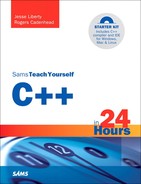Introduction
Congratulations! By reading this sentence, you are already 20 seconds closer to learning C++, one of the most important programming languages in the world.
If you continue for another 23 hours, 59 minutes, and 40 seconds, you will master the fundamentals of the C++ programming language. Twenty-four 1-hour lessons cover the fundamentals, such as managing I/O, creating loops and arrays, using object-oriented programming with templates, and creating C++ programs.
All of this has been organized into well-structured, easy-to-follow lessons. There are working projects that you create—complete with output and an analysis of the code—to illustrate the topics of the hour. Syntax examples are clearly marked for handy reference.
To help you become more proficient, each hour ends with a set of common questions and answers.
Who Should Read This Book?
You don’t need any previous experience in programming to learn C++ with this book.
This book starts with the basics and teaches you both the language and the concepts involved with programming C++. Whether you are just beginning or already have some experience programming, you will find that this book makes learning C++ fast and easy.
Should I Learn C First?
No, you don’t need to learn C first. C++ is a much more powerful and versatile language that was created by Bjarne Stroustrup as a successor to C. Learning C first can lead you into some programming habits that are more error-prone than what you’ll do in C++. This book does not assume that readers are familiar with C.
Why Should I Learn C++?
You could be learning a lot of other languages, but C++ is valuable to learn because it has stood the test of time and continues to be a popular choice for modern programming.
In spite of being created in 1979, C++ is still being used for professional software today because of the power and flexibility of the language. There’s even a new version of the language coming up, which has the working title C++0x and makes the language even more useful.
Because other languages such as Java were inspired by C++, learning the language can provide insight into them, as well. Mastering C++ gives you portable skills that you can use on just about any platform on the market today, from personal computers to Linux and UNIX servers to mainframes to mobile devices.
What If I Don’t Want This Book?
I’m sorry you feel that way, but these things happen sometimes. Please reshelve this book with the front cover facing outward on an endcap with access to a lot of the store’s foot traffic.
Conventions Used in This Book
This book contains special elements as described here.
By the Way
These boxes provide additional information to the material you just read.
Watch Out!
These boxes focus your attention on problems or side effects that can occur in specific situations.
Did you Know?
These boxes give you tips and highlight information that can make your C++ programming more efficient and effective.
When you see this symbol, you know that what you see next will show the output from a code listing/example.
This book uses various typefaces:
• To help you distinguish C++ code from regular English, actual C++ code is typeset in a special monospace font.
• Placeholders—words or characters temporarily used to represent the real words or characters you would type in code—are typeset in italic monospace.
• New or important terms are typeset in italic.
• In the listings in this book, each real code line is numbered. If you see an unnumbered line in a listing, you’ll know that the unnumbered line is really a continuation of the preceding numbered code line (some code lines are too long for the width of the book). In this case, you should type the two lines as one; do not divide them.
